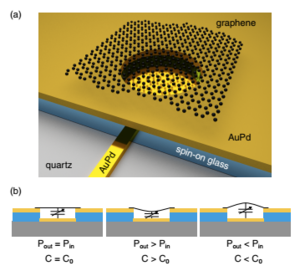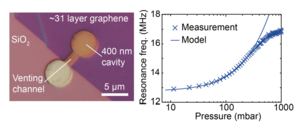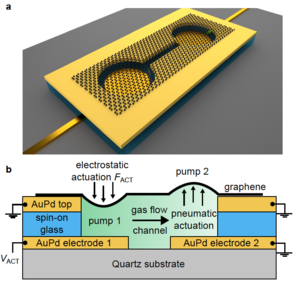Theory and Fundamentals
Micro and nano-mechanical components at the first glance seem to obey classical mechanics. However, many phenomena and properties in these devices are still fundamentally unclear. Two dimensional materials, for instance, can show intrinsic tensions, which could be related to manufacturing effects, but might also have a fundamental origin like Brownian fluctuations or van der Waals forces at the clamping point. Moreover, understanding the non-linearities at the nano scale is still elusive. For instance, damping of nano-membranes is high, non-linear and strongly temperature dependent for unknown reasons. Therefore, in this research theme we focus on the fundamentals and physics of micro and nano-mechanical systems (such as cantilevers, beams, and membranes) and their non-linear dynamics behaviour.
-
The characterization of biological molecules and cells in lab-on-a-chip devices is one of several achievements reached by the Nano/Micro-Electro-Mechanical-Systems (NEMS/MEMS) community. Among diverse configurations, hollow microstructures have shown superior qualities in terms of dynamic range and damping performance with the capability of placing the liquid inside the structure. This indeed provides new opportunities for mass-based flow cytometry and inspection of biological samples. The goal of this project is to introduce a new methodology for mass sensing applications in liquid exploiting highly sensitive nanophotonic cavities.
-
As materials scale down, the classical continuum models fail to give accurate results, thus higher-order elastic theories must be applied to account for contributions from strain gradients. The goal of the project is to determine higher-order length-scale parameters used in the non-classical theory by inspecting the correlation of results given by a semi-analytical solution and molecular dynamics simulations.
-
We'll be measuring the non-linear motion of ultra-high Q membrane resonators using laser light. Our latest designs allow us to begin exploring this nanoscale motion at metamaterial membranes designed to trap vibrations.
-
Complex oxides have received recent attention for their extraordinary quantum properties, yet it is a material that has yet to be explored for nanophotonic and nanophononic sensors. In this project, we will be designing nanostructures we can test for towards combining these for nano-mechanical sensors and high-frequency optical switches.
Design and Fabrication
Fabrication methods are key prerequisites for the study of the dynamics of micro and nanosystems. Although quite some work on archetypical devices like graphene drums has been performed, the fabrication and characterization of mechanical devices from 2D materials is still in its infancy. Current device fabrication methods have low yield, show large device-to-device variations and are not compatible with high-volume manufacturing. We intend to improve these methods, both by internal device fabrication and by collaborations with leading groups and companies. The facilities at TU Delft are excellent to achieve this goal, since nano and microstructures, with proper electrode configurations, can be created in the Kavli Nanolab and the Else Kooi Lab. We have collaborations with the companies Graphenea and Applied Nanolayers that transfer their CVD graphene layers on our structures.
-
In this project we are designing nanophotonic membranes for inertial navigation and test the latest in nanofabrication.
-
-
-
In this project we design and develop acoustic nanotweezers to localise, pattern and manipulate biomolecules using acoustic trapping forces.
https://www.canevalab.com/
Experimental Characterization
Experimental characterization of nanoscale devices is an important challenge. Since device dimensions are smaller than the optical wavelength, optical methods have their limitation. On the other hand, measurements by scanning probe techniques like AFM have the drawback of strong tip-device interactions that modify device properties and are not able to capture the dynamics of these devices at high frequencies. Therefore, the investigation of novel actuation and detection methods for MEMS and NEMS will be a key aspect of this research line.
Furthermore, for designing and developing the ultimate NEMS devices, reliable and efficient descriptions of their dynamic response are essential. Therefore, another mission of the group is the theoretical characterization and development of accurate numerical tools that can be used in design of NEMS devices.
-
Although 2D NEMS devices have shown promising applications, their development is still far from being considered well-established. One of the problems is the large variability that can be seen in mechanical properties of these devices obtained by available techniques. For instance, Young’s modulus of Graphene membranes has been reported between 0.1 and 1 TPa. In this project we aim at developing new methods utilizing nonlinearities for mechanical characterization of 2D materials
-
Propagation of micro-cracks in silicon-based devices cause malfunction in a large number of integrated circuits and microelectromechanical systems. In this study, using a combined theoretical and experimental scheme, we investigate the effect of damage on the nonlinear response of micro structures.
-
The objective of this project is designing a test set up for enabling modal testing of microsystems which have to operate in fluidic environment. Examples include submerged AFM cantilevers to facilitate the imaging of biological samples.
-
In this project we study the energy transfer mechanisms in 2D material nanopores to fingerprint peptides and proteins.
https://www.canevalab.com/
Applications
The research results of the other three research lines will position the group perfectly to study and develop new devices that can serve as prototypes for applications. As a consequence of their small mass and high flexibility, resonating cantilevers and nano membranes are extremely sensitive to external forces. For this reason it is the plan to study their use as mass sensors, stiffness sensors, pressure sensors, and gas sensors.
-
Micro and nano resonators have been successfully applied for detection of biological organisms such as bacteria, viruses and DNA. The ongoing challenge in this project is to utilize dynamics for developing biomechanical sensors capable of rapidly assessing characteristic properties of biological samples with the aim to help in early medical diagnosis.
-
In this project we use acoustic-structure interactions and the photophysical properties of 2D materials to scan single molecules through nanopores and optically detect clinically-relevant labeled residues.
https://www.canevalab.com/




